Reflections on counterbalance looms
This article will describe the most common Swedish 4-shaft counterbalance loom, with one pulley and two "horses" each side.
There is also a part 2, which describes "dräll" pulleys - or many-level pulleys.
Bergdala Spinnhus |
|
- About 4-shaft counterbalance looms (Scandinavian style) - About multi-shaft (dräll pulley) CB looms - About jämtlandsdräll - Thoughts about "overshot" - Some rag weave facts - Om vadmal - Om färgeffekt - About fabric analyis - bindningskonstruktion (opens in new window) - About construction of double layers - About weaving double width - Double width, part 2 - About profile patterns - How to expand a profile pattern - More about profile patterns - Om tagelvävning - About differential shrinkage - Solid colour? - Om datoriserad vävstol - About old wooden reeds - About reading old literature - About Hulda Peters vävbok - threading notations, part 1 - threading notations, part 2 - About horsehair - Tageltyg från Småland - ideas about displaying - "Original", kopia eller plagiat? - A survey of Swedish weaving books - Om tyst kunskap - Nog nu! in English: - Serial weaving - "TWILL" - Block substitution - Vadmal |
|
Reflections on counterbalance loomsThis article will describe the most common Swedish 4-shaft counterbalance loom, with one pulley and two "horses" each side. There is also a part 2, which describes "dräll" pulleys - or many-level pulleys. |
||
|
The most common Scandinavian counterbalance (CB) loom has one pulley which holds two horses in each side.
This setup can handle two, three or four shafts, depending on how you tie the horses to the shafts.
Swedish looms have looked like this for centuries, with only small variations.
This article will, hopefully, describe the mechanics of such a loom. |
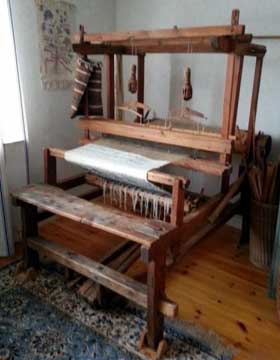
|
|||
|
Starting with only two shafts (and no horses), looking at one of the pulleys from the side:
|
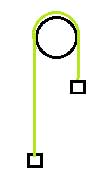
|
|||
|
At some point in history, weavers saw that they could easily add more shafts by adding "horses".
|

|
|||
|
Now it is the horses that are connected over the pulley, and the horses are connected to the shafts.
A schematic view from the top, and a photo: |

|
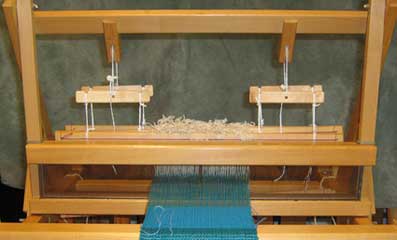
|
||
|
Let the horses hang level, and lower the two foremost shafts – the two back shafts go up, and the horses are still
level (but not at the same height).
The function is the same as above, with the difference that there are two shafts on each side of the pulley. |
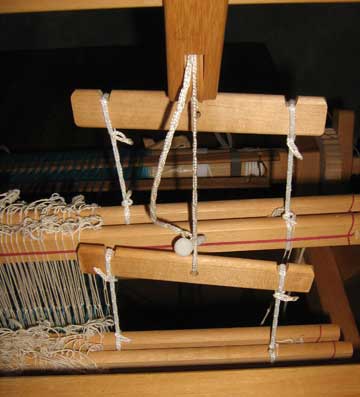
|
|||
|
Next logical step: the horses can tilt.
If a tabby is treadled (assuming a straight threading), the horses pivoting point stays at the same level, but the horses themselves tilt. This means that shaft 1 and 3 go down, and because of the mechanics, shafts 2 and 4 go up. |
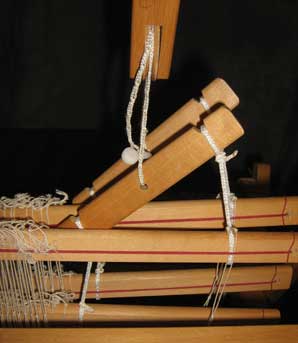
|
|||
|
Now, if we combine the movements: say that we want shafts 1,2 and 3 to go down, the following happens:
The front horse goes down (and stays level) - therefore the back one comes up, and tilts. With correctly tied treadles, this will give an "unbalanced" shed. The same happens if we want only one shaft to go down: the horse of that shaft tilts, and goes down – the other horse comes up, like the shaft connected to the top of the tilted horse.
|
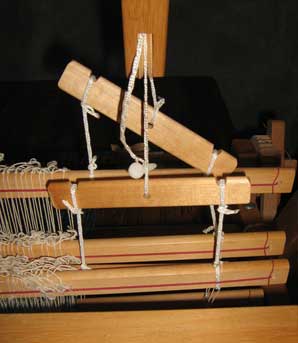
|
|||
|
And... just to prove that the resulting sheds are adequate and even, some pictures from the side:
This loom is a small folding one, with the brand name Göta. Let me call it a "compromize" loom, meant
to be easily moved, folds with warp in place.
|
||||

|
||||
|
And that is all there is to it!
For part 2, about conterbalance with "dräll" pulleys, click here! |
||||